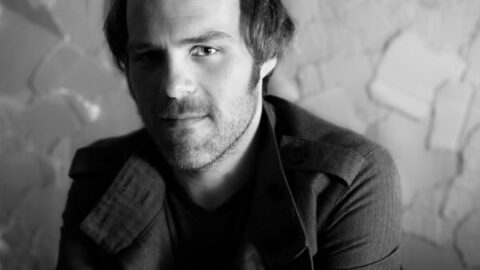 Michael Lewanski, conductor of Chicago’s Ensemble Dal Niente, introduced saxophonist (and EDN Executive Director) Ryan Muncy with his tongue in his cheek and a point to make. He reeled off a list of famous saxophone practitioners from Charlie Parker, to John Coltrane, to Bill Clinton, to Kenny G and Lisa Simpson, without naming a single classical musician. The occasion was the release event for Muncy’s first CD, HOT (on New Focus Recordings), at Constellation Chicago on September 22, 2013. Lewanski’s purpose was not only to decry the dearth of repertoire for classical saxophone, but also to extol Muncy and his collaborating composers for staking out new territory for the saxophone in contemporary music.
Michael Lewanski, conductor of Chicago’s Ensemble Dal Niente, introduced saxophonist (and EDN Executive Director) Ryan Muncy with his tongue in his cheek and a point to make. He reeled off a list of famous saxophone practitioners from Charlie Parker, to John Coltrane, to Bill Clinton, to Kenny G and Lisa Simpson, without naming a single classical musician. The occasion was the release event for Muncy’s first CD, HOT (on New Focus Recordings), at Constellation Chicago on September 22, 2013. Lewanski’s purpose was not only to decry the dearth of repertoire for classical saxophone, but also to extol Muncy and his collaborating composers for staking out new territory for the saxophone in contemporary music.

Muncy strapped on his saxes and quickly demonstrated what all the fuss is about, playing three tracks from the new recording – The Last Leaf (2012) for sopranino by Chaya Czernowin, Refrain from Riffing (2008) for alto and detuned harp by Anthony Cheung, and Aaron Cassidy’s Asphyxia (2000) for soprano. He rounded out the program with Andrea Agostini’s gli atomi che s’accendevano e radiavano (2009) for baritone and live electronics and Tre Pezzi (1965) for soprano and tenor by Giacinto Scelsi.
Muncy opened with the Agostini, his baritone on a slow deep burn with percussive bubbling electronics repeating a whirlwind of notes. There were moments when Muncy was doing little more than breathing and clicking on the valves evoking a barren landscape, followed by relentlessly repeating bari blasts over very loud electronics, as if he had been breathing life into the creation of the universe.
Listen to “Refrain from Riffing” from Ryan Muncy’s HOT.
The Last Leaf, which we heard at its world premiere in November 2012, was even stronger now as Muncy has matured his presentation of this terrifyingly difficult piece. The sopranino is so tiny, it almost looks like a toy, save for its intricate jewel-like keys and fittings. It is notoriously resistant to bending to the player’s will, so playing it is always a high-risk venture. But Czernowin spares nothing in her demands for the piece. Starting with quiet spare bleats and toneless percussive tapping, Muncy suddenly dropped a bomb of deep, unrelenting, impossibly low blasts. A cycle of acrobatic register leaps repeated, exploring the full range of the sopranino’s sonic palette, ending with a high strained run of nearly breathless notes.
Scelsi’s Tre Pezzi was the most melodic piece of the evening, though there were plenty enough screeches to satisfy the contemporary music audience. A first section on soprano was a deconstructed blues full of obtuse angles. It gave way to a middle eastern modal passage that could have charmed a snake. Switching to tenor, Muncy laid out a slow and gentle lullaby, tinged with melancholy, that slowly disintegrated into silence. The spirited finale on soprano brought a bright run of birdsong.
Prior to joining Muncy for Cheung’s Refrain from Riffing, harpist Ben Melsky explained the scordatura tuning for the piece. 12 of the harps strings are detuned — six to a quarter-tone sharp, and six to a quarter-tone flat — lending gnarly and eerie overtones, especially during glissandos. Muncy’s alto part had a very jazzy feel as Melsky added acerbic commentary from his harp. Melsky accompanied a fractured, jittery sax melody with low-string harp plucks that evoked jazz bass playing. This piece had a jangly, confusing feel, in a thoroughly pleasing way.

The oversized score for the closing Asphyxia has two parallel staves, one for the fingering and the other for the blowing. Muncy described it as the scariest piece he has ever tackled. And by the time it was over, Muncy and the audience were in desperate need of oxygen. The piece was crazy-time, with a frenetic, chaotic feel and no clear rhyme or reason for nearly any of the playing. It felt like an exercise in just how disconnected can you get a saxophonist’s key-tapping and breathing without he or she collapsing in defeat.
By the end of the program Muncy looked exhausted, as well he should have been after hard-blowing five different saxophones. The remaining three pieces on the CD were not played because they require other musicians not available for the event. Anyone interested in the latest contemporary saxophone repertoire would do well to check HOT out.
























